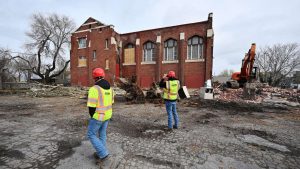Hughes Stadium demolition shows that recycling, not junking, forsaken buildings is possible
Published by John on
If Northern Colorado had more recycling options, more projects might look like the Hughes Stadium demolition. The high-profile project is required to divert at least 70 percent of waste from the landfill. Hughes’ main ingredients, concrete and steel, are the easiest to recycle. The steel will go to local metal recyclers, said Tony Flores, project manager for Colorado State University Facilities Management. Connell Resources will use rock-crushers to mash roughly 40,000 tons of concrete into 1-inch chunks for use in regional construction projects. Recycled concrete is in high demand as construction picks up and mined aggregate becomes harder to find, said John Warren, Connell’s vice president of operations.
“The benefit is two-fold,” he said. “It reduces the amount of waste going to the landfill, but it also helps alleviate some of the demand for virgin aggregate.” Finding new uses for other pieces of Hughes proved a bit trickier but still doable. CSU found buyers for the stadium’s old FieldTurf and plastic seating. The turf will become patches for other playing surfaces throughout the nation. A company agreed to remove metal from the seats and melt down the plastic for other uses. CSU-Pueblo installed Hughes’ old south end zone video scoreboard at its football stadium last summer.
The Hughes demolition follows in the footsteps of other projects with high landfill diversion, like the 2014 construction of both Woodward Inc.’s Lincoln campus, and the Foothills Mall project, which diverted 72 percent. Projects like those demonstrate it’s possible to keep waste out of the landfill as Fort Collins grows and changes, but city staff said recycling at worksites can be hit-or-miss. Recyclable materials are easily lost in piles of rubble, and workers must be trained to source-separate and follow guidelines carefully.
“The biggest difference I see when I’m out on sites is how bought-in the site’s leadership is,” Nagel said. “If you have a site where the superintendent really wants to do good, they’ll do really well. And then there’s a lot of sites that don’t particularly (prioritize) recycling, and they’re gonna scrape by in comparison.” Fort Collins can also tackle the waste issue by encouraging builders to use recycled, locally sourced materials and design buildings to reduce environmental impacts. City staff hope to roll out incentives for green building practices in early 2019, green building coordinator Tony Raeker said. The incentives could involve money, technical assistance, expedited review or publicity for green building projects. The goal is to inspire builders to think beyond building code requirements, Raeker said. “Once builders and contractors learn best practices, even if their next project isn’t green, they still apply a lot of them,” he added. “Once they’ve mastered the best way to do something, there’s not a lot of reasons not to do it.”
Hear about regional waste plans at an upcoming open house
The North Front Range Regional Wasteshed Planning Coalition is planning a series of open houses to share its master plan for trash and recycling once the Larimer County Landfill closes in 2025.
Jacy Marmaduke, jmarmaduke@coloradoan.com




